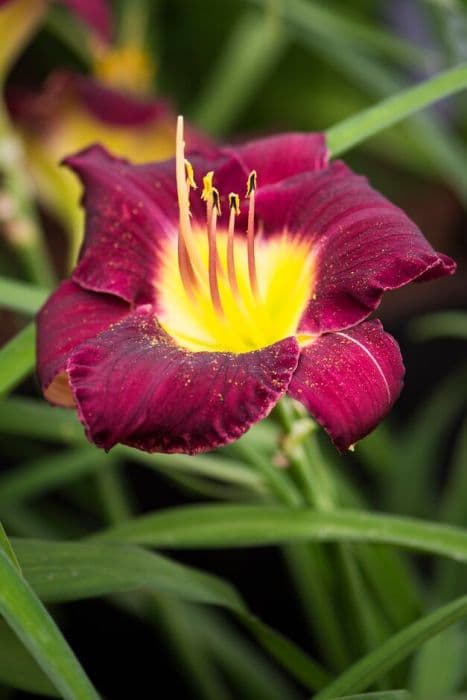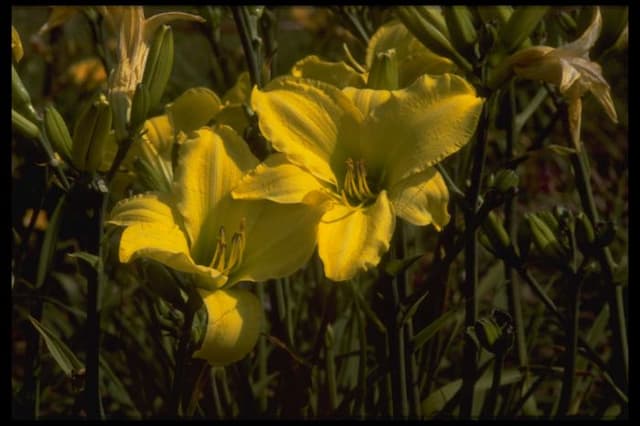Daylily Hemerocallis 'Chicago Sunrise'

ABOUT
The Hemerocallis 'Chicago Sunrise', commonly known as the Daylily, is a perennial plant that is known for its striking flowers. The blooms of the Chicago Sunrise are large, with an appealing trumpet shape that opens wide to showcase their beauty. The flowers typically have a warm, rich orange color that resembles the vibrant hues of a sunrise, which is where the cultivar gets its name. Each petal may display a subtle gradient of shades, ranging from a deep, fiery tone at the edges to lighter tones near the flower's throat. The petals often feature a slightly ruffled or wavy margin, adding to their visual interest. The Daylily's flowers consist of three petals and three sepals, which are similar in color and size, together creating a symmetrical form. These colorful flowers are perched atop tall, strong stems known as scapes, which rise above the plant's foliage. The foliage of the Daylily is equally attractive, forming dense clumps of long, narrow leaves. The leaves are arching and strap-like, with a lush green color that provides an elegant backdrop to the vivid blooms. When the Daylily is in full bloom, it becomes a focal point in gardens due to the contrast between its fiery blossoms and verdant leaves. The overall appearance of the Hemerocallis 'Chicago Sunrise' is one of resilience and beauty, and it brings a splash of warm color to any landscape where it is grown.
About this plant
 Names
NamesFamily
Hemerocallidaceae
Synonyms
Daylily
Common names
Hemerocallis 'Chicago Sunrise'.
 Toxicity
ToxicityTo humans
The Hemerocallis 'Chicago Sunrise' is commonly known as a daylily. Daylilies are not considered toxic to humans, and in fact, some parts can be edible when properly prepared. However, it is important to note that not all parts of the daylily are edible, and one should always be cautious and knowledgeable about the proper preparation methods. Ingesting parts not typically used for consumption or eating them in large quantities could potentially cause discomfort, although there are no well-documented cases of poisoning from daylilies in humans. Thus, daylilies like 'Chicago Sunrise' do not pose a significant risk of toxicity to people.
To pets
The Hemerocallis 'Chicago Sunrise', also known as a daylily, is considered toxic to certain pets, especially cats. Ingesting even a small amount of any part of the plant can cause kidney failure in cats, which is a potentially life-threatening condition. Symptoms of poisoning in pets, particularly cats, can include vomiting, lethargy, inappetence, and changes in urination habits. If you suspect your pet has consumed any part of a daylily, immediate veterinary attention is required. While they are toxic to cats, daylilies are not generally considered toxic to dogs, but can potentially cause mild gastrointestinal upset if ingested.
 Characteristics
CharacteristicsLife cycle
Perennials
Foliage type
Deciduous
Color of leaves
Green
Flower color
Orange
Height
2-3 feet (0.6-0.9 meters)
Spread
2-3 feet (0.6-0.9 meters)
Plant type
Herb
Hardiness zones
3-9
Native area
Asia
Benefits
 General Benefits
General Benefits- Low Maintenance: Daylilies require minimal care once established, making them ideal for busy gardeners.
- Drought Tolerant: They can survive periods of low water, reducing the need for frequent irrigation.
- Pest Resistant: Daylilies are generally resistant to many pests, reducing the need for pesticides.
- Aesthetic Appeal: 'Chicago Sunrise' offers bright, vibrant flowers that enhance the beauty of any garden space.
- Long Blooming Period: This variety has a lengthy blooming season, providing color for an extended time.
- Adaptable: They can thrive in a range of soil types and environmental conditions.
- Erosion Control: Their root systems can help stabilize soil and prevent erosion.
- Edible: Some parts of daylilies are edible for humans and can be used in culinary dishes.
 Medical Properties
Medical PropertiesThis plant is not used for medical purposes.
 Air-purifying Qualities
Air-purifying QualitiesThis plant is not specifically known for air purifying qualities.
 Other Uses
Other Uses- Edible Flowers: The blooms of the daylily can be used in salads, soups, or as a garnish, providing a sweet flavor and a pop of color to various dishes.
- Natural Dye: The flowers of the daylily, particularly the 'Chicago Sunrise', can be used to create a natural dye for fabrics or paper, yielding colors that range from soft yellows to vibrant oranges.
- Garden Aesthetics: Due to its bright colors and attractive form, 'Chicago Sunrise' can be used to enhance the visual appeal of garden beds and borders.
- Crafting: Dried daylily flowers can be used in potpourri or as part of floral arrangements and wreaths to maintain a natural aesthetic in home decor.
- Photography Subject: The striking appearance of the daylily makes it a popular subject for garden photographers and artists looking for vibrant, natural subjects.
- Erosion Control: The root system of the daylily can help stabilize soil and prevent erosion when planted on slopes or areas prone to soil loss.
- Mood Enhancer: Placing daylilies in living spaces can add a cheerful element and enhance the mood of the occupants with their bright color and form.
- Companion Planting: Daylilies can be used in companion planting schemes to complement other perennials in terms of height, texture, and bloom time.
- Culinary Experimentation: The daylily lends itself to experimentation in culinary applications, such as being infused into vinegars or oils to add a subtle floral note.
- Water Features: Though not a water plant, daylilies like 'Chicago Sunrise' can be planted around ponds or water features to add color and interest without the need for a wet soil environment.
Interesting Facts
 Feng Shui
Feng ShuiThe Daylily is not used in Feng Shui practice.
 Zodiac Sign Compitability
Zodiac Sign CompitabilityThe Daylily is not used in astrology practice.
 Plant Symbolism
Plant Symbolism- Beauty: The Hemerocallis, commonly known as the Daylily, is admired for its beautiful blooms, symbolizing the appreciation for beauty and natural aesthetics.
- Motherhood: In Chinese culture, daylilies are a symbol of motherhood and are often given to mothers to celebrate their nurturing nature.
- Forgiveness: The ephemeral nature of each flower, which lasts only for a day, represents the idea of forgiveness and letting go of past grievances.
- Transience: The short-lived blossom serves as a reminder of life's fleeting nature, symbolizing the transient quality of human existence.
- Renewal: Since daylilies produce new flowers daily, they are seen as a symbol of renewal, new beginnings, and the constant rebirth of opportunities.
 Water
WaterDaylilies should be watered deeply once a week, ensuring that the soil is moistened to a depth of about 8 inches. For an established plant, use about 1 to 1.5 gallons of water, depending on the soil type and environmental conditions. During periods of hot weather or drought, increase watering to twice a week. It is crucial to avoid overhead watering to prevent foliage diseases; instead, water at the base of the plant. In the fall, reduce watering as the plant prepares for dormancy.
 Light
LightDaylilies thrive in full sunlight, receiving at least 6 to 8 hours of direct sun daily. The best spot for a 'Chicago Sunrise' daylily is in an area where it can enjoy morning sun and some afternoon shade, particularly in regions with very hot summers. However, too much shade can decrease the number of blooms and weaken the plant.
 Temperature
TemperatureDaylilies prefer temperate conditions and can tolerate a wide range of temperatures. The ideal temperature range for a 'Chicago Sunrise' daylily is between 60°F and 90°F. They can survive minimum temperatures down to about -20°F in winter, and maximum temperatures of around 110°F in summer when properly cared for.
 Pruning
PruningPrune daylilies to remove spent flower stems (scapes) and dead foliage to encourage reblooming and to maintain a tidy appearance. The best time for pruning is immediately after a bloom cycle is completed. Pruning a few times during the growing season as needed promotes healthy growth and flowering.
 Cleaning
CleaningAs needed
 Soil
SoilThe best soil mix for Daylilies (Hemerocallis 'Chicago Sunrise') should be well-draining, slightly acidic to neutral, with a pH range of 6.0 to 7.0. A blend of loamy garden soil, compost, and a bit of sand or perlite to improve drainage will suit this plant well.
 Repotting
RepottingDaylilies, including the 'Chicago Sunrise,' generally do not require frequent repotting and can thrive in the same spot for several years. However, if the clumps become overcrowded, dividing and repotting into a larger space can be done every 3 to 5 years.
 Humidity & Misting
Humidity & MistingDaylilies, like 'Chicago Sunrise,' are tolerant of a wide range of humidity levels and do not have specific requirements in this regard. They are well-suited to outdoor garden conditions.
 Suitable locations
Suitable locationsIndoor
Ensure bright light, adequate water, and good airflow.
Outdoor
Plant in full sun to part shade, enrich soil, moderate water.
Hardiness zone
3-10 USDA
 Life cycle
Life cycleThe daylily 'Chicago Sunrise' begins its life as a seed, germinating in warm soil with adequate moisture to initiate root and shoot development. It progresses to a vegetative state, where leaves develop and the root system expands, forming a clump of foliage as an herbaceous perennial. The plant then reaches the reproductive stage during early to mid-summer, where it produces tall flower stalks known as scapes that bear the vibrant, large, and trumpet-shaped flowers, characteristically opening for just one day. After pollination, which may occur by insects or wind, the flowers develop into capsules containing numerous seeds. As the growing season ends, the daylily enters a period of dormancy, especially in regions with cold winters, where the foliage dies back and the plant conserves energy in its roots. With the return of warm weather in spring, the daylily 'Chicago Sunrise' emerges from dormancy, repeating its growth cycle.
 Propogation
PropogationPropogation time
Early spring
Hemerocallis 'Chicago Sunrise', commonly known as the Daylily 'Chicago Sunrise', is ideally propagated in late summer to early fall after the flowering period is over. The most popular method of propagation for Daylilies is through division, which involves separating the clump of roots into smaller sections. To propagate by division, dig up the entire clump of the plant with a garden fork, gently lifting it out of the ground. Carefully tease apart the individual fans, which are groupings of leaves with their own root system, making sure that each division has a good amount of roots attached. Replant the divisions at the same depth they were previously growing, spacing them about 18 to 24 inches apart (approximately 45 to 60 cm). Water the new plantings thoroughly to help establish them. This method is effective because it not only propagates new plants but also invigorates the parent plant by reducing overcrowding.









